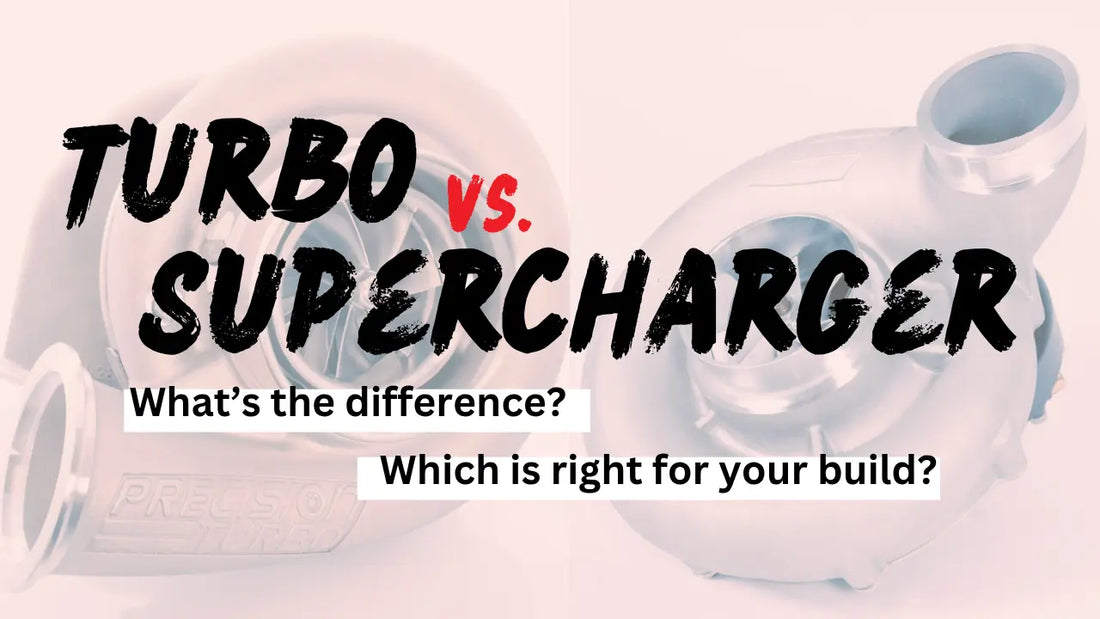
Superchargers vs. Turbochargers: What’s the Difference and Which Is Right for Your Build?
If you're getting into the world of forced induction, you've probably heard the terms supercharger and turbocharger thrown around. While both systems are designed to increase horsepower by forcing more air into the engine, they do it in fundamentally different ways—and that difference can impact everything from throttle response to maintenance to how your car feels on the street or the track.
Let’s break down the key differences between supercharging and turbocharging a car, and help you decide which one might be best for your goals.
How They Work: The Basics
Supercharger
A supercharger is mechanically driven by the engine—usually via a belt connected to the crankshaft. This means it delivers boost almost instantly as soon as you touch the throttle. There’s no waiting for exhaust pressure to build up; the boost is always there.
Types of Superchargers:
- Roots-style: Great for low-end torque, often seen in muscle cars.
- Twin-screw: More efficient than Roots, with better thermal performance.
- Centrifugal: Similar in behavior to a turbo, with boost building at higher RPMs.
Turbocharger
A turbocharger is powered by the engine’s exhaust gases. As exhaust pressure builds, it spins a turbine that drives a compressor, which forces air into the intake. Because it relies on exhaust energy, there's a brief lag before it spools up—often called turbo lag.
Types of Turbochargers:
- Single turbo: Simpler and more common.
- Twin-turbo: Two smaller turbos can reduce lag.
- Twin-scroll, variable-geometry, electric-assist: These modern systems improve responsiveness and efficiency.
Power Delivery
- Superchargers deliver linear power—torque builds evenly as RPM climbs. This gives a more predictable driving experience, ideal for road racing or aggressive street driving.
- Turbochargers tend to deliver a surge of power once boost builds, especially in smaller engines. This can feel more dramatic and exciting, but requires skill to manage, especially in RWD platforms.
Efficiency and Fuel Economy
- Superchargers draw power directly from the engine, so they create parasitic loss. They give instant boost, but at the cost of efficiency.
- Turbochargers, on the other hand, use wasted exhaust energy, making them more efficient. That’s one reason turbos are favored in modern OEM applications aiming for both performance and fuel savings.
Installation and Tuning Complexity
- Supercharging is often easier to install and tune, especially in older vehicles. There’s no need to tap into the exhaust system, and the linear response is easier on drivetrains.
- Turbocharging can be more complex to install and dial in, particularly with custom setups. Turbo kits require plumbing for oil, coolant, and exhaust, and tuning is critical to avoid detonation.
Heat Management
Turbochargers generate more heat due to their location and method of operation (exhaust-driven). This can affect intake temps and underhood components, so intercoolers and heat shielding are crucial. Superchargers also create heat, but generally run cooler overall.
Maintenance and Longevity
- Superchargers are mechanically simpler but put more constant load on the engine.
- Turbos have more components that can fail (wastegates, bearings, etc.) and often run hotter, but modern systems are far more reliable than early designs.
Cost
Turbocharging can sometimes offer more horsepower-per-dollar—if you’re comfortable with custom fabrication or buying a complete kit. Superchargers are more expensive upfront but can be easier to install and maintain, which might make the total cost more predictable.
Which Should You Choose?
It depends on your build and how you plan to use the car:
| Goal/Use Case | Recommended Option |
|---|---|
| Street car, daily drive | Turbocharger (for efficiency and tuning potential) |
| Drag racing | Either, but supercharger for consistency off the line |
| Road course / track | Supercharger (linear response, predictable power) |
| Budget build | Turbocharger (more power potential per dollar) |
| Simplicity / ease | Supercharger (bolt-on systems) |
Final Thoughts
Both superchargers and turbochargers are excellent ways to add serious performance to your build—but they offer very different experiences behind the wheel. Superchargers give you instant response and predictable power. Turbos give you higher efficiency and wild top-end gains—at the cost of more complexity.
At the end of the day, it comes down to your power goals, budget, and how you want the car to feel on the road or track. Whichever you choose, proper tuning, cooling, and supporting mods are key to making the most of any forced induction system.
Need help deciding on the right forced induction setup for your build? Schedule an Engine Build Advising Appointment—we can help you choose the right components, machining, and tuning path to hit your goals.
